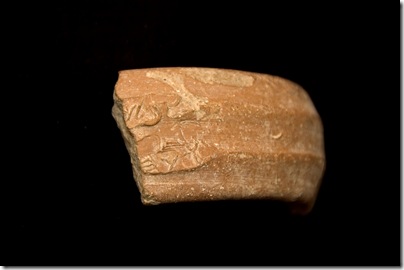The subject of the “Israeli-Palestinian Cultural Heritage Agreement,” and similar subjects, has largely been ignored on this blog (for reasons of time). Joe Lauer today sent out a handy summary of the issue, which I re-post here with his permission. He also points out that there are a few additional links at Paleojudaica.
From Joe Lauer:
The recent Op-Ed by Meron Benvenisti, published in Ha’aretz, is another article or opinion piece dealing with the draft “Israeli-Palestinian Cultural Heritage Agreement” introduced by two archaeologists on April 8, 2008. The archaeologists are Ran Boytner, from UCLA, and Lynn Swartz Dodd, from USC.
As I was away from our PC from early April through mid-May, I could not share the news and opinions about the draft with those on the list, although many undoubtedly were made aware of them through their own reading or through postings on other lists.
For those who did not have access to these materials, the following mentions some of the items that appeared in early April and thereafter. I’m sure that many other article and op-eds have appeared regarding the proposal.
On April 8, 2008, UCLA issued a lengthy press release regarding the draft agreement (“Plan brokered by archaeologists would remove roadblock to Mideast peace”). This release, which has a picture of the two archaeologists, a map of the “Proposed Jerusalem Heritage Zone”, and a link to an almost eight-minute UCLA video about the draft, evidently was the basis for many of the following articles on the subject. It may be read here.
The video may be also be viewed at http://www.youtube.com/watch?v=wkRATNj8WDo.
On April 14, 2008, ScienceDaily published the UCLA press release at http://www.sciencedaily.com/releases/2008/04/080411123057.htm. It also has a link to the UCLA video.
On April 9, 2008, The Jerusalem Post published a brief news item on the subject (“Israeli, Palestinian archaeologists draft deal to preserve historic sites”) by its staff. It may be read here or here.
On April 10, 2008, The Jerusalem Post (pg. 7) reprinted an article by Tom Tugend that first appeared on April 7 [sic], 2008 in The Jewish Journal of Greater Los Angeles (“UCLA and USC archaeologists hope preserving the Middle East’s shared past can pave way to protecting”). It may be read here.
The Jerusalem Post article was entitled “US academics work to bridge archeological gap between Israelis, Palestinians” (and sub-captioned “Effort yields database of sites, artifacts that could be caught in legal limbo when final borders are decided”).
Unfortunately, I do not have the URLs for The Jerusalem Post article or the Letter to the Editor that responded to it from Ken Spiro, April 14, 2008, pg. 14 (“Preposterous plan”), although I have them in print form. (The letter stated: “I read with complete disbelief about a plan to return to the Palestinian Authority archaeological artifacts excavated from Judea and Samaria as part of a final peace deal (“US academics …,” April 10). If these were Muslim or Arab artifacts I could at least understand, but they’re talking about the Dead Sea Scrolls, antiquities from the First and Second Temple periods — our very history, and the physical evidence of the Jewish people’s connection to Israel! To even contemplate giving these to the PA — which continues to deny that there ever was a Jewish presence in Israel or Jerusalem — is a form of national suicide. As Israel Meir Lau, former chief rabbi of Israel and now chief rabbi of Tel Aviv, once said: ‘A nation that does not value its past has no right to dream about its future.'”)
The Jewish Journal article was also circulated by Common Ground News Service, in a slightly edited form (“Archaeologists preserve hope”), at http://www.commongroundnews.org/article.php?id=22977.
The Jewish Journal article has a picture of the two academics, a link to the “Plan” of the “Shared Heritage Project”, and a link to the UCLA video about the agreement. The Plan (including All documents (includes the cover letter, agreement, map) 5.32 MB; Agreement only 37.5 KB; High resolution Jerusalem Heritage Zone Map 2.11 MB; and Low resolution Jerusalem heritage zone map 932 KB) may also be linked to at http://www.usc.edu/dept/LAS/religion/arc/sh/.
Ha’aretz also had its articles and opinion pieces on the subject:
On April 11, 2008, Ha’aretz published “A separate peace”, by Meron Rapoport. It may be read at http://www.haaretz.com/hasen/pages/ShArt.jhtml?itemNo=973870 [English; Last update – 20:38 14/04/2008]
http://www.haaretz.co.il/hasite/pages/ShArt.jhtml?itemNo=973829 [Hebrew; Last update – 15:22 12/04/08]
On April 18, 2008, Ha’aretz published “Partitioning the past”, by Neil Asher Silberman. It may be read at http://www.haaretz.com/hasen/pages/ShArt.jhtml?itemNo=976273 [English; Last update – 07:41 18/04/2008]
Silberman’s critical piece was followed by a response (“Sharing the past by dividing it”) from Raphael Greenberg, who often speaks for the “Israeli-Palestinian Working Group on Archaeology,” including in a campaign against the IAA excavations in the City of David sponsored by Elad. His article may be read at http://www.haaretz.com/hasen/pages/ShArt.jhtml?itemNo=977945 [English; Last update – 09:19 25/04/2008].

